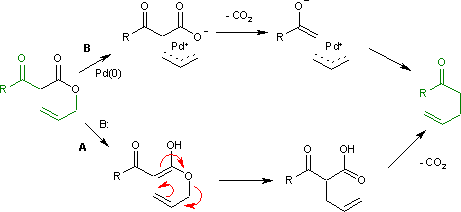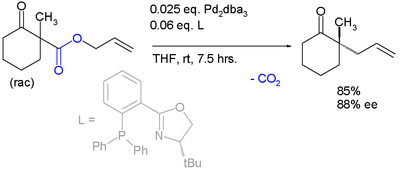Carroll rearrangement
Source: Wikipedia, the free encyclopedia.
Chemical reaction
The Carroll rearrangement is a
allyl ester into a α-allyl-β-ketocarboxylic acid.[1] This organic reaction is accompanied by decarboxylation and the final product is a γ,δ-allylketone. The Carroll rearrangement is an adaptation of the Claisen rearrangement
and effectively a decarboxylative allylation.
Reaction mechanism
The Carroll rearrangement (1940) in the presence of
organometallic complex.[2]

Decarboxylation precedes allylation as evidenced by this reaction catalyzed by tetrakis(triphenylphosphine)palladium(0):[3]

Asymmetric decarboxylative allylation
By introducing suitable chiral ligands, the reaction becomes
enantioselective.[4]
The first reported
asymmetric rearrangement is catalyzed by tris(dibenzylideneacetone)dipalladium(0) and the Trost ligand:[3]

A similar reaction[5] uses additional naphthol.

This reaction delivers the main enantiomer with 88% enantiomeric excess. It remains to be seen if this reaction will have a wide scope because the acetamido group appears to be a prerequisite.
The same catalyst but a different ligand is employed in this
enantioconvergent reaction:[6]

The scope is extended to asymmetric α-alkylation of ketones masked as their enol carbonate esters:[7]

References
- ^
- doi:10.1039/b505105c
- Barry M. Trostand Jiayi Xu
